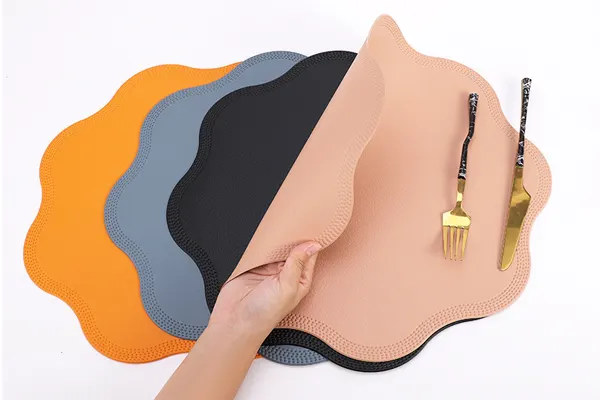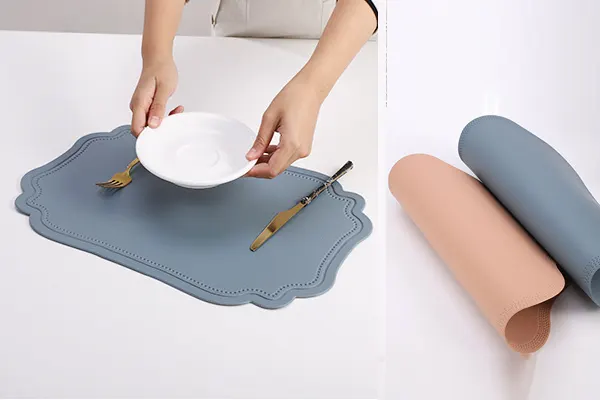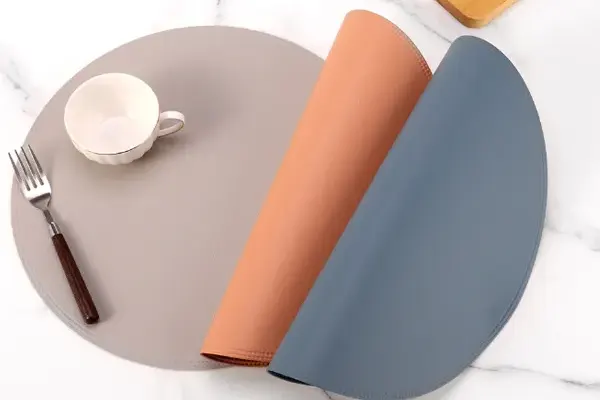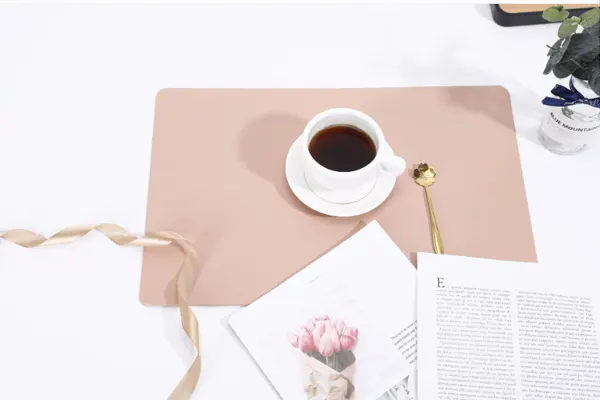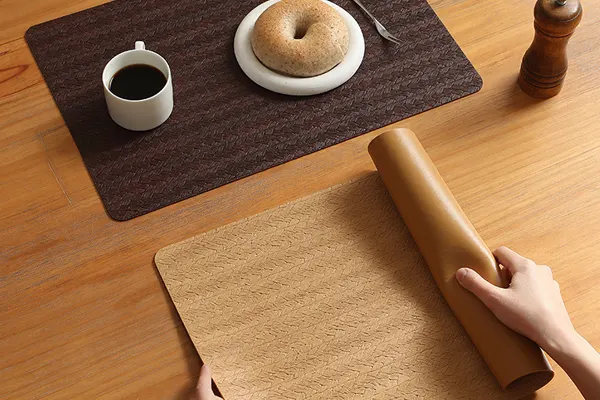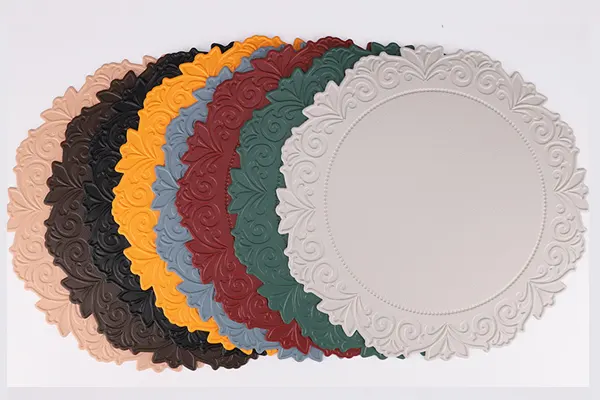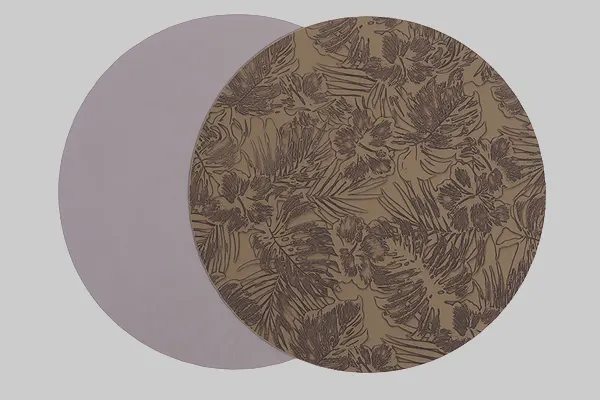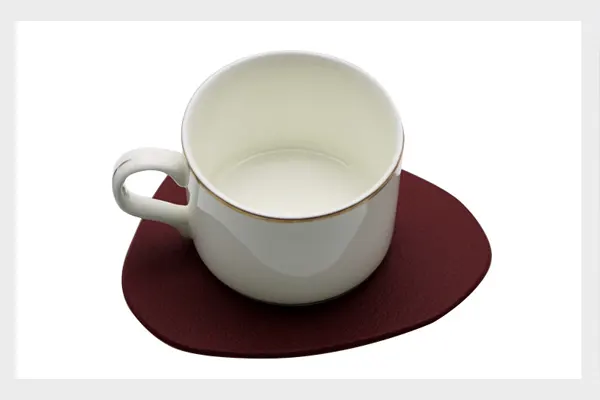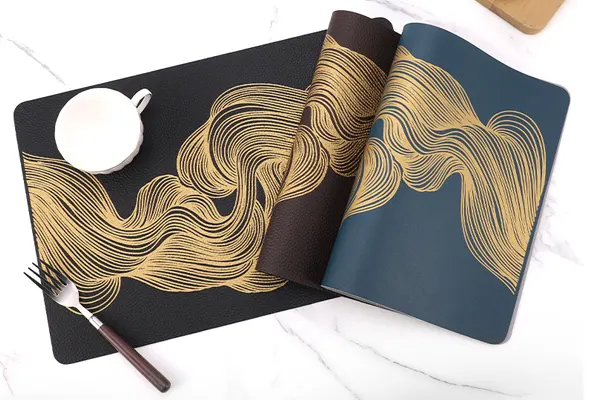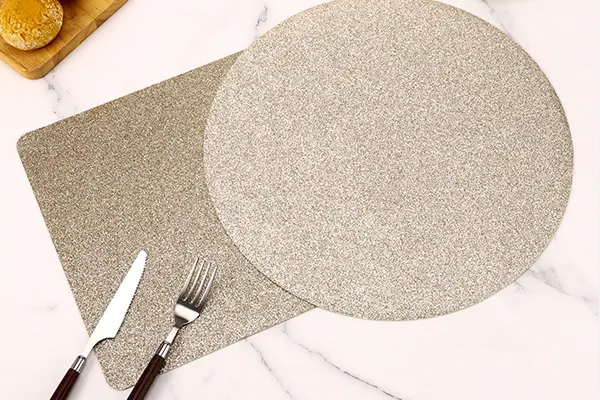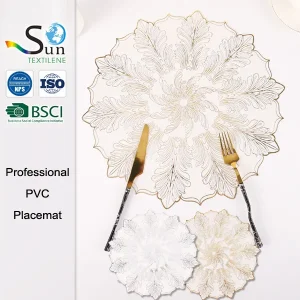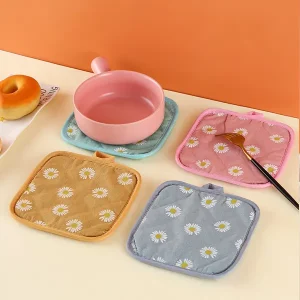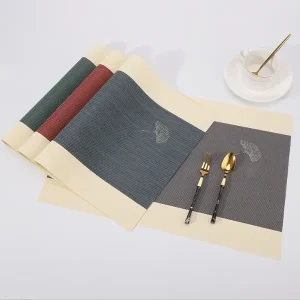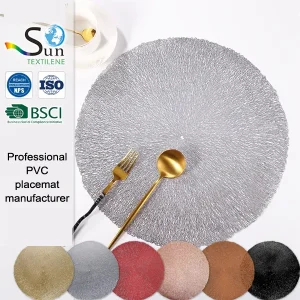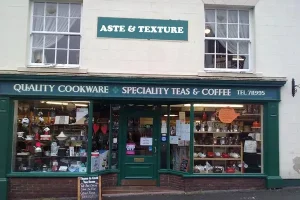Faux Leather Placemat | Everything you need to know
What are faux leather placemats made of?
Faux leather placemats are typically made from synthetic materials designed to mimic the look and feel of genuine leather. The most common materials include:
- Polyurethane (PU): A flexible, durable polymer often used for its leather-like texture, water resistance, and affordability. PU is coated onto a fabric backing, such as polyester or cotton, to create the placemat’s surface.
- Polyvinyl Chloride (PVC): Another popular synthetic material, PVC is used for its smooth, easy-to-clean surface and cost-effectiveness. It can be textured to resemble leather and is often reinforced with a woven or non-woven backing.
- Microfiber with PU Coating: Some higher-end faux leather placemats use microfiber as a base material, coated with polyurethane to enhance softness, durability, and a premium leather-like appearance.
Are faux leather placemats durable for daily use?
Yes, faux leather placemats are generally durable for daily use, making them a practical choice for both home and commercial settings like restaurants. Their durability stems from the synthetic materials used, such as polyurethane (PU) or polyvinyl chloride (PVC), which are designed to withstand regular wear and tear.
For daily use, their durability depends on the quality of the material and manufacturing. Higher-end faux leather placemats with reinforced backings (e.g., polyester or microfiber) tend to last longer—often years with proper care—while lower-quality options may show signs of peeling or fading after heavy use.
How to clean faux leather placemats?
Cleaning faux leather placemats is straightforward due to their synthetic materials, such as polyurethane (PU) or polyvinyl chloride (PVC), which are designed to be low-maintenance and resistant to stains. Here’s a concise guide to cleaning them effectively:
- Wipe Spills Immediately: Use a soft, damp cloth to wipe away food, liquid, or spills as soon as they occur to prevent staining or residue buildup.
- Use Mild Soap Solution: For tougher stains or regular cleaning, mix a small amount of mild dish soap with warm water. Dampen a soft cloth or sponge in the solution and gently wipe the placemat’s surface. Avoid soaking the material to prevent damage to the backing.
- Rinse and Wipe Dry: Use a clean, damp cloth to remove any soap residue, then dry the placemat thoroughly with a soft, dry towel to prevent water spots or damage.
- Avoid Harsh Chemicals: Do not use bleach, alcohol, acetone, or abrasive cleaners, as these can damage the faux leather’s finish or cause discoloration.
- Spot Treat Stubborn Stains: For persistent stains, use a small amount of diluted vinegar or a specialized faux leather cleaner, applied gently with a cloth. Test on a small, inconspicuous area first.
- Regular Maintenance: Dust or wipe placemats regularly to prevent dirt buildup. Store them flat or rolled (not folded) in a dry place to avoid creases or cracking.
Can faux leather placemats withstand heat from hot dishes?
Yes, artificial leather placemats can withstand the heat of hot dishes. But its heat resistance has a certain temperature range. Here’s a concise overview:
- Moderate Heat Tolerance: Most faux leather placemats can handle temperatures from hot food (e.g., up to 140–176°F or 60–80°C) without immediate damage, making them suitable for everyday dining.
- Limitations with Extreme Heat: Direct exposure to very high temperatures, such as hot cookware straight from an oven or stovetop (e.g., above 212°F or 100°C), can cause damage like warping, melting, or discoloration, especially in lower-quality placemats.
- Quality Matters: Higher-quality faux leather placemats with thicker coatings or reinforced backings (e.g., polyester or microfiber) tend to offer better heat resistance than thinner, cheaper alternatives.
- Best Practices: To protect faux leather placemats, use trivets or coasters for extremely hot items (e.g., casserole dishes or pots). Of course, you can choose to use natural plant-based placemats to solve the problem of high temperatures, such as water hyacinth placemats, wheat straw placemats, and jute placemats.
What is the difference between faux leather and genuine leather placemats?
| Feature | Faux Leather Placemats | Genuine Leather Placemats |
|---|---|---|
| Material Composition | Synthetic materials (PU or PVC) on a fabric backing (e.g., polyester, microfiber). | Natural animal hides (e.g., cowhide), tanned and processed. |
| Durability | Highly durable, resistant to water and stains; lower-quality versions may peel over time. | Durable but prone to scratches and stains without proper care; develops a patina. |
| Cost | Affordable, ideal for bulk orders. | Expensive due to natural material and processing costs. |
| Maintenance | Easy to clean with a damp cloth and mild soap; low-maintenance. | Requires conditioning and careful cleaning to avoid damage. |
| Water/Stain Resistance | Naturally water- and stain-resistant. | Less resistant unless treated; coatings may wear off. |
| Environmental Impact | Vegan-friendly but often petroleum-based; some eco-friendly options available. | Involves animal processing; sustainability depends on tanning practices. |
| Aesthetics/Feel | Uniform look, customizable colors/patterns; may lack natural warmth. | Luxurious, natural texture with unique grain; less consistent appearance. |
| Heat Resistance | Handles moderate heat (60–80°C); may warp under extreme heat. | Less heat-resistant; can scorch or dry out without treatment. |
Are faux leather placemats eco-friendly?
From the perspective of raw materials for artificial leather placemats, they are not as pure and pollution-free as natural plant fiber placemats because the raw materials for artificial leather placemats are by-products of petrochemicals. But from an ecological perspective, it has replaced the fur of wild animals and protected more animals from harm, which is very positive. So I think artificial leather placemats are environmentally friendly
How do faux leather placemats compare to vinyl placemats?
| Feature | Faux Leather Placemats | Vinyl Placemats |
|---|---|---|
| Material Composition | Polyurethane (PU) or PVC on a fabric backing (e.g., polyester, microfiber). | PVC with plasticizers, often without fabric backing. |
| Aesthetics/Feel | Premium, leather-like look and softer texture; upscale appeal. | Glossy, plastic-like finish; casual, vibrant designs. |
| Durability | Durable, water/stain-resistant; lower-quality versions may peel. | Durable, water/stain-resistant; may crack or fade with heavy use. |
| Maintenance | Easy to clean with damp cloth and mild soap; needs gentle care. | Very easy to clean with a quick wipe; slightly more forgiving. |
| Heat Resistance | Handles moderate heat (60–80°C); may warp under extreme heat. | Moderate heat tolerance; some are slightly more heat-resistant. |
| Cost | More expensive due to premium look and feel. | Cheaper, ideal for budget-conscious buyers. |
| Eco-Friendliness | Petroleum-based; some recycled or bio-based options available. | Petroleum-based; fewer eco-friendly alternatives. |
Can faux leather placemats be used outdoors?
Faux leather placemats, typically made from polyurethane (PU) or polyvinyl chloride (PVC), can be used outdoors in certain conditions, but they are not as durable in outdoor settings as materials specifically designed for exterior use.
- Weather Resistance: Faux leather placemats are generally water-resistant, making them capable of handling light moisture, such as spills or brief exposure to rain. However, prolonged exposure to water, humidity, or direct sunlight can cause fading, warping, or peeling.
- UV and Heat Exposure: Extended exposure to sunlight can degrade the synthetic material, causing discoloration or cracking. High temperatures (e.g., above 140–176°F or 60–80°C) may also warp or soften the placemats, particularly if left in direct heat.
- Care Tips for Outdoor Use: Wipe clean after use, store indoors when not in use, and avoid prolonged exposure to sun or rain to maintain their appearance and durability.
Why are artificial leather placemats stain resistant ?
Faux leather placemats are stain-resistant due to the properties of their synthetic materials, typically polyurethane (PU) or polyvinyl chloride (PVC). Here’s why:
- Non-Porous Surface: Unlike genuine leather, which has natural pores that can absorb liquids and stains, faux leather has a smooth, non-porous coating. This prevents food, drinks, or oils from penetrating the surface, making stains less likely to set.
- Protective Coating: The PU or PVC layer is often treated with a protective finish that repels water and common staining agents like wine, coffee, or sauces, allowing spills to be wiped off easily.
- Synthetic Composition: The man-made materials used in faux leather are engineered to resist chemical interactions with common stains, unlike natural materials that may react or discolor.
What are the common sizes of artificial leather placemats?
The size of artificial leather placemats usually needs to be determined based on the actual dining environment. The following are common sizes based on industry standards and market trends:
- 17 x 11 inches (43 x 28 cm): The most popular size, fitting well for individual place settings on standard dining tables, balancing functionality and aesthetics.
- 18 x 12 inches (46 x 30 cm): Slightly larger, offering more surface coverage, commonly used in restaurants or formal dining settings.
- 19 x 13 inches (48 x 33 cm): Used for larger tables or upscale dining environments where more table protection or a premium look is desired.
- 14 x 14 inches (35 x 35 cm) or 15 x 15 inches (38 x 38 cm): Often used for modern or minimalist table settings, ideal for square tables or smaller dining spaces.
- 15 inches (38 cm) in diameter: Common for circular placemats, suitable for round tables or as a stylish accent in casual or fine dining settings.
- Customized Size: How to provide customers with special placemat shapes and sizes? Please feel free to contact me at any time, and we will provide you with a satisfactory placemat solution
How do you store faux leather placemats to prevent damage?
To store faux leather placemats and prevent damage, follow these simple steps to maintain their appearance and durability, which is especially relevant for B2B clients like wholesalers or restaurants who handle bulk inventory:
- Clean Before Storing: Wipe placemats with a damp cloth and mild soap to remove any food, grease, or dust. Ensure they are completely dry to prevent mold or mildew.
- Store Flat or Rolled: Lay placemats flat in a stack or roll them loosely to avoid creases or cracks. Do not fold them, as folding can cause permanent lines or damage the synthetic coating.
- Use a Cool, Dry Place: Store in a well-ventilated area away from direct sunlight, heat sources, or high humidity, as prolonged exposure to UV rays or heat can cause fading, warping, or peeling.
- Avoid Heavy Pressure: Don’t stack heavy items on top of placemats, as excessive weight can deform or crush the material, especially for thinner faux leather.
- Use Protective Layers: If stacking, place a soft cloth or acid-free tissue paper between placemats to prevent sticking or scratching, particularly for PU-based ones with softer finishes.
- Keep Away from Chemicals: Store away from solvents, oils, or harsh chemicals that could degrade the synthetic material.
Are faux leather placemats safe for kids’ dining tables?
Faux leather placemats are generally safe for kids’ dining tables. Why? Here are the reasons:
- Non-Toxic Materials: Most faux leather placemats are made with food-safe, non-toxic PU or PVC that complies with safety standards (e.g., FDA or EU regulations for food contact). However, ensure the placemats are labeled as BPA-free and phthalate-free, as some low-quality PVC may contain harmful chemicals.
- Durability and Spill Resistance: Faux leather is water-resistant and stain-resistant, ideal for messy eaters. Spills from juice, food, or crayons can be easily wiped clean with a damp cloth, reducing safety concerns related to bacteria buildup.
- Smooth Surface: The non-porous surface minimizes sharp edges or splinters, unlike some natural materials, making it safe for kids to touch or use.
- Heat Tolerance: Faux leather can handle moderate heat from warm plates (e.g., 140–176°F or 60–80°C), but hot cookware should be avoided to prevent burns or material damage, which is a consideration for kids’ safety.
- Potential Risks: Low-quality faux leather may degrade over time, potentially releasing small particles if cracked or peeled. Always recommend high-quality, certified products for kids’ environments. Additionally, ensure placemats are stable and non-slip to prevent dishes from sliding during use.
Do faux leather placemats have a strong chemical smell?
Faux leather placemats, typically made from polyurethane (PU) or polyvinyl chloride (PVC), may have a mild chemical smell when newly manufactured due to their synthetic materials, but this varies by quality and production process. :
- Initial Odor: New faux leather placemats, especially those made from PVC, can have a noticeable chemical or plastic-like smell due to volatile organic compounds (VOCs) used in manufacturing. PU-based placemats generally have a milder odor compared to PVC.
- Quality Matters: High-quality faux leather placemats, particularly those labeled as low-VOC or eco-friendly, tend to have minimal or no noticeable smell. Lower-quality options may have a stronger, more persistent odor.
- Dissipation Over Time: Any chemical smell typically fades within a few days to a week if the placemats are aired out in a well-ventilated area. Washing with a damp cloth and mild soap can also help reduce odors.
How long do faux leather placemats last?
The lifespan of faux leather placemats depends on their quality, usage, and maintenance. High-quality faux leather placemats can last 2–5 years with regular use in dining settings, while lower-quality ones may last 1–2 years before showing signs of wear.
Factors Affecting Longevity:
- Quality: Premium PU-based placemats with reinforced fabric backings are more durable than thin, low-cost PVC versions, which may peel or crack sooner.
- Usage: Heavy daily use in high-traffic settings like restaurants can shorten lifespan compared to occasional home use. Exposure to frequent spills, abrasions, or cleaning affects durability.
- Maintenance: Proper care, such as wiping with a damp cloth and mild soap, avoiding harsh chemicals, and storing flat or rolled in a cool, dry place, extends their life.
- Environmental Factors: Prolonged exposure to sunlight, heat, or humidity can cause fading, warping, or peeling, reducing lifespan.
Partner with us to meet your faux leather placemat solutions
Are you looking for a faux leather placemat supplier? We specialize in high-quality faux leather placemats. We have been in this field for many years and provide OEM services for many well-known household brands around the world.
We understand the needs of customers like you. We can provide you with high-quality faux leather placemats. Let’s discuss your specific requirements so that we can provide you with exclusive faux leather placemat customization solutions.
Latest placemats
Cooperation Cases
Explore more meal mat solutions
Are you ready to start your meal mat procurement journey?
Are you ready to start your meal mat procurement journey?
We will provide perfect solutions and competitive quotations based on your procurement needs, including material, quantity, logo customization, and other factors

